第一章、语言与语言学
- 格式:doc
- 大小:142.50 KB
- 文档页数:17
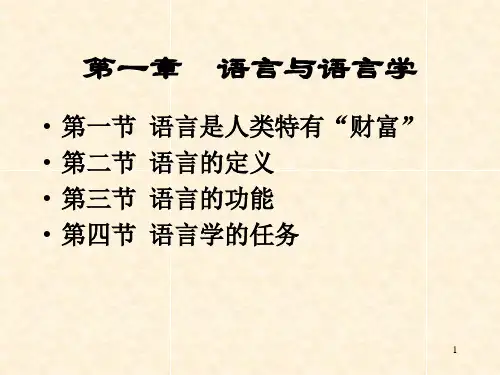

第一章语言和语言学1.语言与各个领域的社会活动都有着密切的联系,在这种情况下,语言学必须明确自己的研究对象,才能成为一门现代意义上的科学。
2.任何符号,包括语言符号都是形式和意义的统一体。
3.什么是语言的客观存在形式语言的客观存在形式首先表示为有声的口头语言即口语,而当出现了文字以后,又表现为有形的书面语言即书面语。
4.语言符号的强制性正因为语言符号是社会约定俗成的,因此在同一社会,同一时代,对使用同一种语言的每一个社会成员来说是强制性的,是不能任意改变的,因为如果个人可以任意改变,那就互相听不懂了,也就从根本上丧失了交际工具的作用。
5.语言与言语的区别语言是言语活动中同一社会群体共同掌握的、有规律可循而又成系统的那一部分;而含有个人要素或个人杂质的说话行为和说出来的话只能属于言语。
第二章语音1.声音的四要素:音高,音强,音长,音质2.振幅:也就是发音体振动时离开平衡位置的最大偏移距离。
3.频率:发音体在每一秒钟内振动的次数。
4.音高:就是声音的高低。
它是由频率的大小决定的。
频率同音高成正比。
频率越大,声音越高;频率越小,声音越低。
5.音强:就是声音的强弱。
它是由振幅的大小决定的。
振幅同音强成正比,振幅的大小又决定于使发音体振动外力的大小。
外力大,振幅就大,声音就强;外力小,振幅就小,声音就弱。
6.音长:就是声音的长短。
它是由发音体振动的持续时间决定的。
发音体振动的持续时间长,声音就长;发音体振动的时间短,声音就短。
7.基音:振动中有一个频率最低的振动,由它发出的声音叫做“基音”。
其他振动发出的声音叫做“陪音”。
8.乐音:当基音的频率的陪音的频率之间存在着整数倍的比例关系时,会形成一种复杂而有规则的,具有周期性重复特征的声波形式,这种声音叫做乐音。
9.噪音:如果基音的频率和陪音的频率之间不存在整倍数的比例关系,就会形成一种杂乱无章的不规则的声波形式,这种声音叫做噪音。
10.语音的生理基础:语音是由人的发音器官协同动作而产生的,人的发音及其运动是“语音的生理基础”,决定着语音的生理特征。
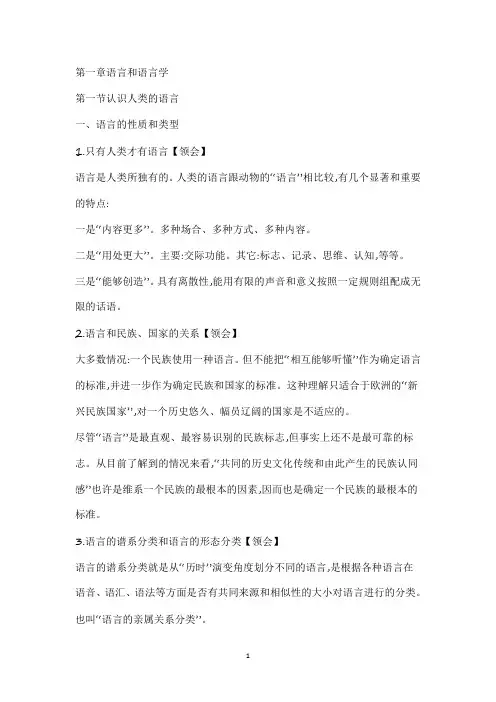
第一章语言和语言学第一节认识人类的语言一、语言的性质和类型1.只有人类才有语言【领会】语言是人类所独有的。
人类的语言跟动物的“语言”相比较,有几个显著和重要的特点:一是“内容更多”。
多种场合、多种方式、多种内容。
二是“用处更大”。
主要:交际功能。
其它:标志、记录、思维、认知,等等。
三是“能够创造”。
具有离散性,能用有限的声音和意义按照一定规则组配成无限的话语。
2.语言和民族、国家的关系【领会】大多数情况:一个民族使用一种语言。
但不能把“相互能够听懂”作为确定语言的标准,并进一步作为确定民族和国家的标准。
这种理解只适合于欧洲的“新兴民族国家”,对一个历史悠久、幅员辽阔的国家是不适应的。
尽管“语言”是最直观、最容易识别的民族标志,但事实上还不是最可靠的标志。
从目前了解到的情况来看,“共同的历史文化传统和由此产生的民族认同感”也许是维系一个民族的最根本的因素,因而也是确定一个民族的最根本的标准。
3.语言的谱系分类和语言的形态分类【领会】语言的谱系分类就是从“历时”演变角度划分不同的语言,是根据各种语言在语音、语汇、语法等方面是否有共同来源和相似性的大小对语言进行的分类。
也叫“语言的亲属关系分类”。
从语言的“共时”角度来划分不同的语言,可以建立“语言的形态分类”,也叫“语言的结构类型分类”。
可分为“形态语”和“孤立语”,或者分成“综合性语言”和“分析性语言”。
4.语系、语族;屈折语、孤立语;综合性语言、分析性语言【识记】谱系分类层级:语系、语族、(语支)、语言、方言、次方言(土语)。
语系是根据语言有无历史同源关系划分出来的语言类别,是语言谱系中最大的类。
语系的下一级叫作“语族”,同一语族的语言不但有相同的来源,相似点也更多。
形态语(综合性语言)指通过词的形态变化来体现各种结构意义的语言。
包括“屈折语、黏着语”等小类。
如俄语、维吾尔语。
孤立语(分析性语言)指没有形态变化的语言。
如汉语。
屈折语主要是句子中某些词本身有丰富的形态变化,是形态语中的一个小类。

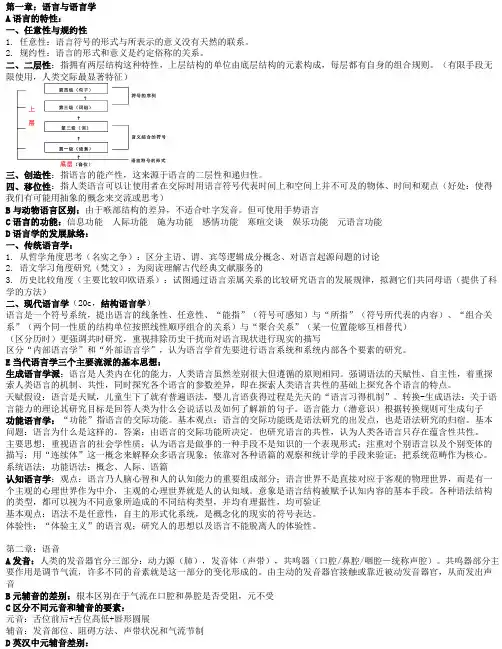
第一章:语言与语言学A语言的特性:一、任意性与规约性1. 任意性:语言符号的形式与所表示的意义没有天然的联系。
2. 规约性:语言的形式和意义是约定俗称的关系。
二、二层性:指拥有两层结构这种特性,上层结构的单位由底层结构的元素构成,每层都有自身的组合规则。
(有限手段无限使用,人类交际最显著特征)三、创造性:指语言的能产性,这来源于语言的二层性和递归性。
四、移位性:指人类语言可以让使用者在交际时用语言符号代表时间上和空间上并不可及的物体、时间和观点(好处:使得我们有可能用抽象的概念来交流或思考)B与动物语言区别:由于喉部结构的差异,不适合吐字发音。
但可使用手势语言C语言的功能:信息功能人际功能施为功能感情功能寒暄交谈娱乐功能元语言功能D语言学的发展脉络:一、传统语言学:1.从哲学角度思考(名实之争):区分主语、谓、宾等逻辑成分概念、对语言起源问题的讨论2. 语文学习角度研究(梵文):为阅读理解古代经典文献服务的3. 历史比较角度(主要比较印欧语系):试图通过语言亲属关系的比较研究语言的发展规律,拟测它们共同母语(提供了科学的方法)二、现代语言学(20c,结构语言学)语言是一个符号系统,提出语言的线条性、任意性、“能指”(符号可感知)与“所指”(符号所代表的内容)、“组合关系”(两个同一性质的结构单位按照线性顺序组合的关系)与“聚合关系”(某一位置能够互相替代)(区分历时)更强调共时研究,重视排除历史干扰而对语言现状进行现实的描写区分“内部语言学”和“外部语言学”,认为语言学首先要进行语言系统和系统内部各个要素的研究。
E当代语言学三个主要流派的基本思想:生成语言学派:语言是人类内在化的能力,人类语言虽然差别很大但遵循的原则相同。
强调语法的天赋性、自主性,着重探索人类语言的机制、共性,同时探究各个语言的参数差异,即在探索人类语言共性的基础上探究各个语言的特点。
天赋假设:语言是天赋,儿童生下了就有普遍语法,婴儿言语获得过程是先天的“语言习得机制”。


第一章语言和语言学第一节语言一语言与言语(一)语言的概念语言是一种特殊的社会现象,是人类用于交际和思维的最重要的工具,是音义结合的符号系统。
(二)语言和言语的关系广义的语言包括语言系统、言语活动和言语作品。
狭义的语言只指语言系统,而言语那么包括言语活动和言语作品。
语言是存在于全社团成员大脑里的相对完整的抽象符号系统;言语是个人在特定语境中对语言的具体运用。
语言与言语既有一系列区别,又有紧密联系。
要紧区别在于:1.语言是抽象的,言语是具体的。
2.语言是社会的,言语是个人的。
3.语言是现成的,言语是临时的。
4.语言是有限的,言语是无穷的。
5.语言是稳固的,言语是多变的。
6.语言是后时的,言语是先时的。
语言与言语又有紧密联系,二者相互依存:一方面,语言来自言语,依存于言语,没有言语,就没有语言。
另一方面,语言又制约着言语,指导人们的言语实践。
语言系统一旦形成,又是人们进行言语交际的依据。
二语言的性质(一)语言的符号性用甲事物代表乙事物,而甲乙两事物之间没有必然的联系,甲事物确实是代表乙事物的符号。
其中甲事物确实是符号的能指(形式),乙事物确实是符号的所指(内容、意义)。
语言符号具有多方面的特点,要紧特点有以下几点:1语言符号的任意性2语言符号的稳固性3语言符号的渐变性4语言符号的线条性语言符号的线条性,或称线性,是指说话时语言符号在时刻上依次显现,像一根线条一样。
(二).语言的系统性所谓系统,是指由假设干相互联系的元素组成的整体。
所谓系统性,确实是指系统元素之间的联系性。
(三).语言的社会性社会性是语言的本质属性:第一,从音义结合的关系看,语言具有社会性。
语言符号中的音义结合是任意性的,是由社会“约定俗成”的。
第二,从语言与社会的彼此依存关系看,语言具有社会性,语言是随社会进展而进展,并随社会消亡而消亡。
语言是社会交际的工具,社会不能没有语言。
(四)语言的民族性(五)语言的生成性三语言的功能(一)语言的社会功能语言的社会功能要紧有交际功能和标志功能。

第一章语言和语言学第一节语言存在的客观形式1.1 什么是语言“语言”不是一种物质实体。
语言存在的客观形式首先表现在人类社会中人与人之间的口头交际行为。
“说话”或者说人与人之间“口头交际行为”,从表面上来看,只是两个人或几个人之间互相交替着“说”和“听”的过程,实际上却是一个非常复杂的过程。
1.2口语和书面语任何一种语言总是先有口语,后有书面语,而且大多数语言在其存在的历史上只有口语而没有相应的书面语。
书面语既不是口语绝对忠实的记录,也不是口语机械的复制品。
书面语和口语在大多数情况下一般是基本一致的。
如果书面语跟口语严重脱节,那么或迟或早最终还是要适应口语的演变而发生变化。
但是应该看到书面语的产生具有重大的社会历史意义。
研究语言首先应该研究口语,并且当口语和书面语在某些方面问题上出现严重分歧的时候一般以口语为主。
但是决不能由于重视书面语的研究而忽视口语的研究,更不能认为书面语是语言研究的唯一对象或主要对象。
1.3语言和民族在绝大多数情况下一个名族使用同一种语言多数人会认为“民族”是一个历史形成的,“具有共同的历史文化传统和民族认同感的社会群体”。
所谓“民族国家”是指这些新兴国家大多数基本上是“一个民族,一种语言,一个国家”的现象,这些国家大多数是以单一民族、单一语言为基础建立起来的,如法国、西班牙、葡萄牙、英格兰、德国等等。
他们区分“语言”和“方言”的标准就是所谓“相互理解程度”【错误】:互相能理解的是同一种语言的不同的方言,互相不能理解的是不同的语言。
实际上只能按照“共同的历史文化传统和民族认同感”再参考社会政治因素来处理。
1.4语言和种族绝大多数人早已认识到语言和种族没有必然联系,因为全世界从生理的角度上能确定的种族为数不多,如蒙古人种,欧罗巴人种,闪米特-哈密特人种,尼格罗人种等有限的几种,但是语言而言,即使只算“语系”而不算下属的具体“语言”至少也有一二十种语系。
1、5语言的客观存在形式和语言研究语言客观存在形式首先表现为有声的口头语言即口语,而当出现文字以后,又表现为有形的书面语言即书面语。
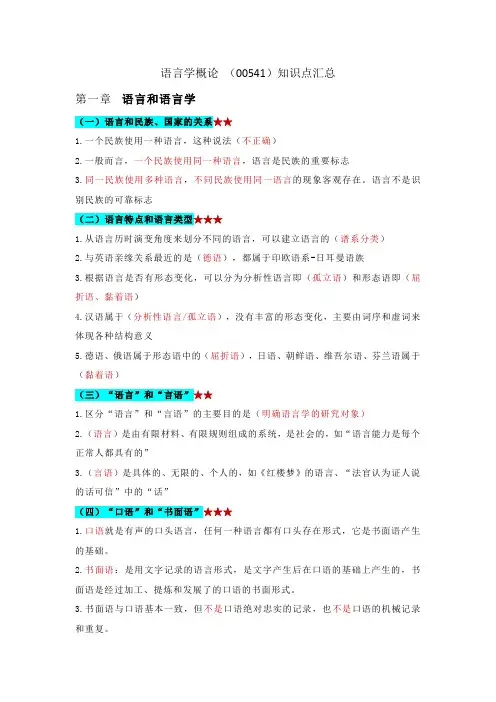
语言学概论(00541)知识点汇总第一章语言和语言学(一)语言和民族、国家的关系★★1.一个民族使用一种语言,这种说法(不正确)2.一般而言,一个民族使用同一种语言,语言是民族的重要标志3.同一民族使用多种语言,不同民族使用同一语言的现象客观存在。
语言不是识别民族的可靠标志(二)语言特点和语言类型★★★1.从语言历时演变角度来划分不同的语言,可以建立语言的(谱系分类)2.与英语亲缘关系最近的是(德语),都属于印欧语系-日耳曼语族3.根据语言是否有形态变化,可以分为分析性语言即(孤立语)和形态语即(屈折语、黏着语)4.汉语属于(分析性语言/孤立语),没有丰富的形态变化,主要由词序和虚词来体现各种结构意义5.德语、俄语属于形态语中的(屈折语),日语、朝鲜语、维吾尔语、芬兰语属于(黏着语)(三)“语言”和“言语”★★1.区分“语言”和“言语”的主要目的是(明确语言学的研究对象)2.(语言)是由有限材料、有限规则组成的系统,是社会的,如“语言能力是每个正常人都具有的”3.(言语)是具体的、无限的、个人的,如《红楼梦》的语言、“法官认为证人说的话可信”中的“话”(四)“口语”和“书面语”★★★1.口语就是有声的口头语言,任何一种语言都有口头存在形式,它是书面语产生的基础。
2.书面语:是用文字记录的语言形式,是文字产生后在口语的基础上产生的,书面语是经过加工、提炼和发展了的口语的书面形式。
3.书面语与口语基本一致,但不是口语绝对忠实的记录,也不是口语的机械记录和重复。
(五)“能指”和“所指”★★★★★1.属于符号的是(语言、文字、红绿灯、旗语)2.符号中能够指称某种意义的成分被称为(能指),符号所指的意义内容是(所指)3.语言符号的能指是(语音),语言符号的所指是(意义)4.首先提出“能指”和“所指”这对概念的语言学家是(索绪尔)5.能指和所指的关系是(不可分割)的,一旦分开,语言符号就不存在了。
(六)“约定”和“任意”★★★★★1.交通信号灯中红灯表示“停”的意思,红灯和“停”之间的关系是(约定的)2.语言符号的任意性是指(语言符号的物质实体和意义内容之间没有必然联系),即:声音和意义之间没有必然联系的理据关系,在语言符号产生之初,它的声音和意义的结合是任意的,是由社会约定俗成的,它们之间的关系是不可论证的3.语言符号具有可变性的根本原因在于语言符号的(任意性)4.语言符号的强制性是指(个人不能任意改变已经约定的符号)(七)“线性”和“离散”★★★1.语言结构的线性特征:语言符号的结构必须是按照时间顺序成一条线的样子排列。

第一章:语言和语言学§1语言的客观存在形式1口语:语言的客观存在形式首先是有声的口头语言。
2书面语:文字出现以后,语的第二种客观存在形式。
3言语交际是一个编码和解码素:生活经历、社会环境、当前处理的问题、社会问化问题、哲学问题、逻辑问题。
人要接受语言所素:组织与分析的能力、心理、生理问题;发音、听音的器官和神经网络及机制和能力;复杂的生理和物理问题。
总之一句话,言语交际是通过许多因素对语言进行编码和解码的过程,言者编码,听者解码。
“码”即所谓的言语4书面语和口语的主要差别。
是那些口语所特有的面部表情、手势和体态,还有口气和语调用书面的文字语言来描述出来的成分,也就是书面语补上的某些省略以后影响理解的成分。
用二者的分析可以用公式理解:口语的基本语言成分=书面语的基本语言成分+用书面描写的口语非语言成分。
5书面语的产生具有重大的社会历史意义。
书面语克服了人和人之间进行交际、和交流思想感情在空间和时间方面的限制,极大地加快了人类社会经验和知识积累的速度和传播的范围,从而大大加快了社会发展的步伐。
6语言和种族的关系。
二者有必然的联系,根本原因是:语言能力和生理因素素有关,但是语言是一种社会现象,完全是在一定的语言环境中后天获得的,所以语言和种族没有必然联系。
7语言与各个领域的社会活动都有着密切的联系,在这种情况下,语言学必须明确自己的研究对象,才能成为一门现代化的,可以从各个不同的角度,根据不同的需要,去研究客观存在的语言的各个不同的方面。
门现代意义上的科学首先要有明确的研究对象,然后才有可能形成自己完整的理论体系和方法论体系,那样才能成为一门现代意义上的科果研究对象长期不确定确,或者研究对象太杂,范围太宽,研究就不可能深入,就不可能形成自己的理论体系和方法论体系。
8什么是语言的客观存在形式。
首先表现为人类社会中人与人之间的口头交际行们每个人从出生那一天起就始终生活在一定的社会群体中。
人类为了繁衍生息,为了共同进行劳动生产,为了保护个人和整个群体,就要相互合作,相互协调,这就需要互相传递信息,互相交流思想感情。
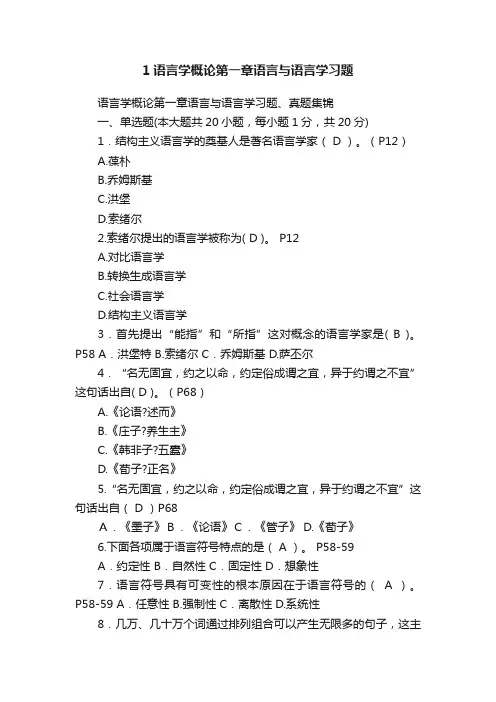
1语言学概论第一章语言与语言学习题语言学概论第一章语言与语言学习题、真题集锦一、单选题(本大题共20小题,每小题1分,共20分)1.结构主义语言学的奠基人是著名语言学家( D )。
(P12)A.葆朴B.乔姆斯基C.洪堡D.索绪尔2.索绪尔提出的语言学被称为( D )。
P12A.对比语言学B.转换生成语言学C.社会语言学D.结构主义语言学3.首先提出“能指”和“所指”这对概念的语言学家是( B )。
P58 A.洪堡特 B.索绪尔 C.乔姆斯基 D.萨丕尔4.“名无固宜,约之以命,约定俗成谓之宜,异于约谓之不宜”这句话出自( D )。
(P68)A.《论语?述而》B.《庄子?养生主》C.《韩非子?五蠹》D.《荀子?正名》5.“名无固宜,约之以命,约定俗成谓之宜,异于约谓之不宜”这句话出自( D )P68A.《墨子》B.《论语》C.《管子》 D.《荀子》6.下面各项属于语言符号特点的是( A )。
P58-59A.约定性 B.自然性 C.固定性 D.想象性7.语言符号具有可变性的根本原因在于语言符号的(A )。
P58-59 A.任意性 B.强制性 C.离散性 D.系统性8.几万、几十万个词通过排列组合可以产生无限多的句子,这主要是由于语言符号具有( A )。
P60-61A.离散性 B.强制性 C.可变性 D.任意性9.语言是一种( C )。
P49A.自然现象B.生理现象C.社会现象D.个人现象9.“人有人言,兽有兽语”中的“言”指的是( A )p49A.语言B.言语C.言语行为D.言语作品10.语言符号具有可变性的根本原因在于语言符号的( A )p59A.任意性B.强制性C.离散性D.系统性11.语言符号的任意性是指( B )p59A.人们可以任意使用或创制语言符号B.语言符号的声音和意义之间没有必然联系C.利用语言可以任意给事物或现象命名D.语言符号的语音形式和意义的关系可以任意改变12.下列关于语言符号的表述中,不正确的一项是( D )p60-61A.语言符号包括能指和所指B.语言符号的音和义不可分割C.语言符号音义关系具有任意性D.语言符号不能分解和重新组合13.语言教学理论属于( B )。
最新语言与语言学-第一章语言与语言学人类对于语言的研究已有2000多年的历史, 但至今对于语言的定义以及语言的起源仍时有争议。
语言教学和语言作为外语教学也不是近期才有的事, 如何将语言研究的理论成果应用于外语教学也是随着语言研究的不断深入和对外语教学要求的不断强烈越来越受到重视。
关于语言本身的研究, 经历了语文学、对比语言学、描写语言学、解释语言学、语篇和会话研究等几个大的阶段, 这些理论有些应用于外语教学, 取得了很大的成功, 也有些应用于其他方面(如计算机和人工智能) 造福于人类。
在外语教学的历史长河中, 不论是传统的语法—翻译法和直接法, 还是本世纪变化多样的听说法、视听法、功能法和交际法, 无一不体现了各个阶段人们对于语言的认识程度。
因此, 对于语言的认识、对于语言学基本知识的了解与外语教学的研究有着直接的联系。
本章从这样一个角度出发, 对于语言、语言学的基本概念以及它们和外语教学之间的联系做一简要的介绍与分析, 以期达到纵观全局的效果。
第一节语言学是科学一、什么是语言学?关于语言学的定义, 公认的、简明扼要的定义是:语言学是科学地研究语言的学问。
那么, 什么是语言?怎样地研究算是科学?需要进一步的界定。
本节先简单探讨科学的问题, 下节着重讨论语言的定义。
二、科学的含义1. 广义的科学和狭义的科学说语言学是科学, 可以有两层意思。
广义地说, 我们可以认为不论研究语言的普遍规律, 还是研究某一特定语言的特点, 都是一门学问, 都是要在掌握大量语言素材和语言事实的基础上建立某种语言理论的学问。
狭义地说, “语言学是科学”的说法特指语言学家对待语言研究的科学态度和科学方法, 而运用科学方法和科学态度研究语言正是20世纪语言学的突出特征。
2. 科学的方法运用科学的方法研究语言, 是指运用可以公开交流和描述的方法处理口头的或书面的语言材料, 并依据可以陈述的原则和可以形式化的理论进行证明(Robins, 1989)。
完整版<语言学概论> 第一章: 语言和语言学一识记内容1口语:语言的客观存在形式首先是有声的口头语言2书面语:文字出现后语言的第二种客观存在形式3符号:指的是根据社会的约定俗成使用某种特定的物质实体来表示某种特定的意义而形成的这种实体和意义的结合体4能指:语言符号的物质实体能够指称某种意义的成分5所指:也就是“能指成分”,即特定的物质实体,所指的意义内容6聚合关系:在同一个位置上可以互相替换出现的各个语言单位处在互相可以联想起来的关系之中,因而聚合成为一个类7组合关系:组合关系体现为一个语言单位和前一个语言单位或后一个语言单位,或和前后两个语言单位之间的关系,也体现了部分与整体之间的关系8语言学:是研究语言的科学9普通语言学:语言学界把研究人类社会的语言这种社会现象的一般理论10理论语言学:把研究某种具体语言的语言学称为汉语语言学或英语语言学等等,把侧重理论探讨的称为理论语言学11应用语言学:侧重语言学理论和成果的实际应用12传统语言学:一般泛指20世纪前的语言学,特别是指索绪尔开创的结构主义语言学以前的语言学13结构主义语言学:索绪尔创立的语言学可以称为“结构主义语言学”,至于我国内常说的“结构主义语言学”“结构主义语法”,往往只是指在国外影响较大并且我国语言学界比较熟悉的美国结构主义描写语言学,那只是当代结构主义语言学的一个流派,并不等于受索绪尔影响的整个结构主义语言学二领会内容不用识记,大体知道即可1言语交际是一个编码和解码的过程?答:人要说话所需要的因素:生活经历社会环境当前处理的问题社会问题文化问题哲学问题逻辑问题人要接受语言所需要的因素:组织与分析的能力心理生理问题:发音听音的器官和神经网络及机制和能力:复杂的生理和物理问题总之一句话,言语交际是通过许多因素对语言进行编码和解码的过程,言者编码,听者解码“码”即所谓的言语2书面语和口语的主要差别?答:书面语比口语多了一些成分,是那些口语所特有的面部表情手势和体态,还有口气和语调用书面的文字语言来描述出来的成分,也就是书面语补上的某些省略以后影响理解的成分用二者的一致性来分析可以用公式理解:口语的基本语言成分=书面语的基本语言成分+用书面描写的口语非语言成分3书面语的产生具有重大的社会历史意义?答:书面语克服了人和人间进行交际传递信息和交流思想感情在空间和时间方面的限制,极大地加快了人类社会经验和知识积累的速度和传播的范围,从而大大加快了社会发展的步伐4语言和种族的关系?没有必然的联系,根本原因:语言能力和生理因素心理因素有关,但语言是一种社会现象,完全是在一定语言环境中后天获得的,所以语言和种族没有必然联系5语言与各个领域的社会活动都有着密切的联系,在这种情况下,语言学必须明确自己的研究对象,才能成为一门现代意义上的科学?答:语言客观存在形式是极其多样化的,可以从各个不同的角度,根据不同的需要,去研究客观存在的语言的各个不同的方面要形成一门现代意义上的科学首先要有明确的研究对象,然后才有可能形成自己完整的理论体系和方法论体系,那样才能成为一门现代意义上的科学如果研究对象长期不确定不明确,或者研究对象太杂,范围太宽,研究就不可能深入,就不可能形成自己的理论体系和方法论体系6语言和言语的区别?答:“语言”是言语活动中同一社会群体共同掌握的,有规律可循而又成系统的那一部分因此也可以说“语言”是一个抽象的实体,是从言语活动中抽象出来的全社会约定俗成的一个均质的系统“语言”就有内在一致的规律,而“言语”则很难找到内在一致的规律语言=言语活动-言语,言语带着个人性,语言带着社会性7任何符号,包括语言符号都是形式和意义的统一体?答:无法把语言符号的声音实体和所表示的意义分开:声音离开了意义就不再是语音的声音,意义离开了声音也就不再是语言的意义,而且声音和所表示的意义一旦分开,语言符号也就不存在了语言的形式和意义是语言的两个不可分割的方面8语言符号的强制性?答:语言符号是社会约定俗成的,对使用同一种语言的每一个社会成员来说是强制性的,是不能任意改变的,因为如果个人可以任意改变,那就互相听不懂了,也就从根本上丧失柴交际工具的作用9语言符号的可变性?一方面在口耳相授的过程中细微的偏离现象是不可避免的,时间的推移,细微的偏离积累成明显的差异另一方面社会生活的不断变化,人口的增加,居住条件的改变,民族的形成,国家的出现,书面语的产生生产和科学技术的发展社会内部的阶层和行业等等的分化,都必然会引起语言在功能上的分化和发展10语言是一个系统?语言是一个人和人之间表达思想感情的符号系统,而人的思想感情是非常复杂的,因此表达人的思想感情的语言系统也必然是非常复杂的由语音系统语汇系统语法系统语义系统等子系统组成是各种不同的语言符号根据严密的组织规律分层次组织起来的,不同单位间互相联系互相制约的系统11语言系统的各个子系统的系统性是不平衡的?答:语言系统的各个子系统的系统性是有明显差异的,其中语音系统的系统性最强,几乎达到牵一发而动全身的地步语法子系统的系统性也很强,但比语音系统稍差一些就是按照一定的规律去进行语言的发音时态的变换等等语言系统的各个子系统均有这样的规律12语言系统具有相对的封闭性和自主性?答:系统性还表现为相对的封闭性,整个语言系统是在封闭状态下运转的,在一般情况下不依赖外界因素的支撑,不受外界因素的影响如果没有相对的封闭性也就不成其为一个系统13语言系统的层次性?答:语言的出层次性是就整个语言系统和各个子系统而言语言的层次性是就整个语言系统和各个子系统而言,都是分层次的,不是单一层次的,而且有上位层次下位层次之分大小依次为:语速—词—短语—句子,句子是最小的交际单位,句子和句子可以组合成语篇,语篇是最大的交际单位14组合关系的含义?答:组合关系体现为一个语言单位和前一个语言单位或后一个语言单位,或和前后两个语言单位之间的关系,也体现在部分和部分,整体和部分之间的关系上15聚合关系的含义?答:在同一个位置上可以互相替换出现的各个语言单位处在互相可以联想起来的关系之中,因而聚合成为一个类16组合关系和聚合关系的关系?聚合是在组合关系中体现出来的,或者说是在组合关系中分析出来的,而组合又体现为聚合关系的线性序列17普通语言学的含义和主要研究领域?研究领域包括的内容有:语言的定义,语言学的研究对象,语言和社会的关系,语言和思维的关系,语言本体的语音语法语汇语义和文字的一般规律,不同的语言结构系统的共性和特性等等18应用语言学的性质和主要研究领域?把语言学的理论和具体成果用来为社会实际生活中的某个领域服务,任何一门应用语言学都有自己的理论,都是依据一定的语言学理论结合具体应用领域的需要而形成的,是主要性质主要研究领域:1最早为第二语言教学的理论2实验语音学,是现代通讯领域应用语音学的理论和成果改进通讯质量和效能的体现3计算机的广泛翻译自然语言理解等等结合语言学的理论和成果,形成的新的应用语言学4也可用来侦破刑事案件19古代哲学家对语言的研究古代的语言本体研究?不论中外,古代哲学家都把对语言的哲学思辩作为语言研究的重点印度人希腊人已经对语法进行了深入系统的研究,奠定了后世语法研究的基础中国人则对语义文字音韵进行了深入系统的研究,这些都是对语言本体的研究,即使今天看来也是真正的语言学研究20历史比较语言学的产生?几个阶段:1从16世纪到18世纪,由于国际贸易的发展,西方一些学者懂得的语言和了解的语言大大增多217世纪和18世纪不少人纷纷搜集和编纂多语种的对照词表,有人发现欧亚两洲语言有明显相似之处,并开始加以比较研究,后来语言学吸收近代生理学和声学的研究成果,建立了科学的语音学,并运用其的理论和方法发现语言之间严格的语音对应规律3从18世纪末到19世纪初,历史比较语言学学科终于建立起来了21普通语言学的产生?答:由于语言学在各方面取得的成就,特别是对更多的语言的认识,就有可能产生关于“语言”的一般理论或者说普遍理论,这就是现在的“普通语言学”22索绪尔的主要贡献?主要贡献在从语言本体的角度界定了“语言,明确地限定了语言学的研究对象范围和重点,使语言学脱离了早期什么都研究,什么都难以深入的缺陷,走上研究对象相对单纯,因而有可能逐步形成本学科特有的理论体系和方法论体系的现代科学的道路23社会语言学功能语言学认知语言学等语言学新学派的产生?由于过分强调语言的自主性,企图摆脱语言跟人和社会之间客观存在的千丝万缕的联系,并在不同程度上忽视语义研究,也就越来越显露出自己的局限性,因此,就兴起了社会语言学功能语言学认知语言学24语言学和文学的关系?文学是语言的艺术,文学作品长期以来是语言学的研究素材诗律学修辞学文章学更跟文学创作和文学作品分不开的在基础科段,语言和文学是不分家的25语言学在历史学和考古学中的应用?答:中国甲骨文和金文的辨认全靠汉代语言学家许慎给我们留下了一部《说文解字》,而甲骨文和金文的解读则大大促进了中国古代史的研究古埃及的文字没人能认读,后来语言学家解读了在一块石碑上刻下的这种文字和古希腊文对照的铭文,才解开了古埃及文字之谜,美洲玛雅文字的解读则揭开了欧洲人来美洲以前印第安人历史的神秘面纱26语言学研究在语言规划中的作用?答:确定官方语言和教学语言,民族语言规范化,发展中国家同样需要补课27语言学研究与计算机科学?信息处理是对语言文字资料的处理一方面是现有的语言学研究成果还远远不能满足这方面的要求三思考内容1什么是语言的客观存在形式?答:语音是语言的物质外壳,是语言的客观形式,客观存在形式有两种:一利是有声的口头语言,一种是以文字作为载体的书面语一言2为什么说语言的客观存在形式跟语言学家研究的语言不完全是一模一样的?答:1)语言的客观存在形式有口语和书面语2)不同的人说同一个句子时各有不同,有个人特点同一个人在不同时间地点说同一句话也不能完全相同3)书面语也有个人特点4)语言学家研究的是经过主观的在不同程度上已经理想化和简单化了的语言5)所以说,语言的客观存在形式跟语言学家研究的不同3应该如何理解口语是第一性的,书面语是第二性的?口语是语言的第一种客观存在形式,而书面语是第二种客观存在形式,任一种语言总是先有口语,后有书面语,任何一种书面语又都只能是在口语的基础上产生的,并且或迟或早的总是要随着口语的演变而演变古往今来只有极少数语言在口语的基础上产生了相应的书面语,大多语言只有口语,并不存在书面语4为什么说语言虽然是民族的重要标志,但并不是最可靠的标志?在绝大多数情况下一个民族使用同一种语言,因此语言就成了民族的一个重要标志但是在很多情况下,民族又突破了语言作为标志的现象,这样看来,尽管“语言”是最直观,最容易识别的民族标志,但事实上还不是最可靠的标志,从目前了解到的情况来看,“共同的历史文化传统和由此产生的民族认同感”也许是维系一个民族的最根本的因素,因而也是确定一个民族的最根本的标准5为什么不能单凭“相互理解程度”来区分语言和方言?“相互理解程度”是西方一些语言学家所采用的区分语言和方言的唯一标准,即他们认为:相互不能理解的是不同的语言同时主张:相互能理解的各个方言从属于同一民族语言,使用同一语言的人属于同一民族,使用不同语言的人属于不同的民族其实,这种通过识别“语言”和“方言”,从而识别“民族”的惯例并不具有普遍意义单凭“相互理解程度”,也就是依据语言结构差异的程度,来确定身份未定的“话”是属于同一“语言”的不同“方言”,还是不同的语言,从而确定有关的社会群体是一个民族还是不同的“民族”,这种方法是把复杂的问题过于简单化了,而且很可能会在政治上引起严重的后果,即可能会把本属于同一民族但通话有困难的群体所使用的同一“语言”的不同“方言”当作不同的“语言”,从而认为这些社会群体是不同的民族2客观上,在有些地区,分属于不同国家和民族的居民使用的语言差别很小,甚至是一模一样的“话”,按照“相互理解程度”的理论,这些居民说的“话”应为一种语言,因而他们也应属于一个民族这样推论与客观事实是不相符的3实际上,按照“共同的历史文化传统和民族认同感”,并参考社会政治因素来区分“语言”和“方言”才是正确和可行的处理方式6区分语言和言语有什么意义?答:区别语言和言语是使语言学成为一门真正的现代意义上的科学所必须的,区别语言和言语可以纯化语言学的研究对象,并把对象限制在一个内部一致的出均植系统的范围内,而使语言学回到本体研究部分,从而提高语言学研究的科学性7应该如何理解语言符号的任意性?“符号”有一个根本特性,那就是任何符号都是约定俗成的,符号的物质实体和表示的意义之间没有必然的理据关系8语言符号的离散特征和线形特征对语言系统的结构特点有什么重大意义?语言符号的离散特征和线形特征使语言系统的组合单位的成员之间,整个语流的各个部分之间就都有可能形成各种关系,产生各种相互影响线形特征使离散的语言符号有可能组合成大小不等的语言单位,组合成连续的语流9为什么尽管语言是客观存在的,可是以语言为研究对象的语言学却存在着不同的理论学说和观点?答:1对语言的观察角度不同侧重点不同目的不同依据的理论不同使用的方法不同依据的素材不同等因素会造成语言学存在着不同的理论2即使以上都相同,但由于时代的不同,整个社会的科学发展水平不同,个人的学术水平和学术态度等等主观因素不同,结论也就不可能完全相同3客观语言是浑然一体的,并和参与交际的各方周围的社会环境等等是分不开的语言学家要根据不同的需要运用现有的研究手段对研究现象加以切割分析,然后再进行综合4作为社会现象具有鲜明的地区性民族性和历史性,并永远处于发展演变的过程之中10语言学研究可以有哪些不同的角度?1)着眼于语言的“本体”,也就是重点研究语音语法语汇语义等语言系统内部结构规律:2)着眼于语言的社会功能重点研究语言在社会中的功能以及语言和社会之间的关系和相互影响:(3)着眼于语言和思维之间的关系,重点研究语言和思维之间的相互关系和相互影响(4)还可以是别的角度,如哲学角度或其他角度(5)多角度研究可以促进语言学繁荣第二章语音一识记内容1语音:人的发音器官发出的,负载着一定的意义并作为语言符号系统栽体的声音,是语言的物质外壳2声音的四要素:音高音强音长音质3振幅:发音体振动时离开平衡位置的最大的偏移4频率:发音体在每一秒钟内振动的次数单位赫兹5音高:声音的高低,由频率有大小决定6音强:声音的强弱,由振幅的大小决定7音长:声音的长短由发音体振动的持续时间决定8音质:声音的个性或特色,又叫音色,是一个声音区别于其他声音的基本特征9响度:指人们听觉上所感到的声音的强弱10基音:在复合声波中有一个频率最低的振动,由它发出的音叫“基音”11陪音:复合波中除去基音外,由其他振动发出的声音叫陪音12乐音:当基音的频率和陪音的频率之间存在着整倍数的比例关系时,会形成一种复杂而有规则的具有周期性重复特征的声波形式,这种声音叫做乐音13噪音:如果基音的频率和陪音的频率之间不存在整倍数的比例关系时,就形成一种杂乱无章的不规则的声波形式,这种声音就是噪音14语音的生理基础:语音是人的发音器官协同动作而产生的,人的发音器官及其运动是“语音的生理基础”,决定着语音的生理特征15声门:两片声带之间的空隙叫音声门,两块杓状软骨之间的空隙叫气声门,合称为声门16齿龈:紧靠上齿的凸起的部分17硬腭:上腭前面凹进去的部分18软腭:上腭后面比较柔软的部分19舌叶:舌头自然平伸时,与齿龈相对的部分20舌面:舌叶后面的部分21舌根:与软腭相对的部分是舌面后,叫舌根22口音:当软腭和小舌向后上升并抵住喉壁时,通向鼻腔的通道被堵塞,气流只能从口腔呼出,这样发出的音叫口音23鼻音:气流完全从鼻腔呼出时发出的音24鼻化音:气流同时从口鼻腔呼出时发出的音25主动的发音器官:能够活动的发音器官,如唇舌头软腭等26被动的发音器官:不能活动的发音器官,如上齿齿龈硬腭等二领会:1语音在语言中的作用?1)语音是由人的发音器官发出的,负载一定的意义,并作为语言符号系统载体的声音,语音是语言的物质外壳2)语言借助声音这种可以感知的物质形态,才能使语言成分物质化,无形的意义才能够被传递接收辨别和理解3)人们在进行言语交际时,说话人则听觉器官接收到的这些声音来辨别和理解对方的意思,语言借助声音把说话人和听话人的大脑联结起来4)离开语音这个物质外壳,语言就无法发挥其社会交际工具的作用2语音和一般声音的本质区别?:1)语音是人的发音器官发出的,所以风声雨声等不是语音2语音必然负载一定的意义咳嗽打喃喃的声音是人的,不是语音3)语音负载的意义应属于语言符号系统即使几个人把咳嗽的声音约定为“有人来了”,仍不是语音,因为它没有经过社会的约定俗成而成为语言符号系统的构成要素3音高与发音体的形状和质地的关系?1音高与发音体的形状和质地有关相对而言,大的长的粗的厚的松的发音体振动慢,频率低,发出的声音也低:小的短的细的薄的紧的发音体振动快,频率高,发出的声音也高2)语音的高低和人类声带的长短松紧有关一般而言,妇女和儿童的声带较短较薄,声音就高一些:成年男子声带较长较厚,声音就低一些同一个人的声音的高低变化,靠控制声带的松紧调节4音高在语言中的作用?答:音高变化在语言中有重要作用在汉语等声调语言中,音节内的音高变化可以构成区别意义的声调句子的语调具有丰富的表达功能,而任何语言的语调的主要构成要素都是音高变化5音强与发音体振动的外力的关系?答:音强指声音的强弱它决定于振幅的大小振幅的大小决定于使发音体的外力的大小外力大,振幅就大,声音就强,反之,声音就弱语音的强弱决定于发音时用力的程度和气流量的大小,说话时比较用力,呼出的气流量比较大,发出的声音就比较强,反之,发出的声音就比较弱6音强响度关系密切,但二者又不是一回事?答:指人们听觉上感到的声音强弱,主观感受与客观实际不一定一致实验证明,一个强度大的声音听起来不一定比一个强度较小的音更响亮除了音强外,音高等因素也会对响度产生影响7音强在语言中的作用?答:音强变化在许多语言中有区别意义的作用英语俄语等西方语言的词重音,汉语的轻声都与音强的变化有关比如英语中的content是名词,意思是内容Content是形容词,意思是满意的利用音强位置的变化来区别不同的词汉语中精神第二个字读轻声,是形容词,是活跃,有生气的意思如果第二个字不读轻声,是名词,指人的思想品德宗旨的意思8音长在语言中的作用?答:音长变化在许多语言和一些汉语方言中有区别意义的作用如英语中的feel感觉,与fill填充汉语广州话中的三与心都是利用音长变化来区别意义的9对语言说来说,重要的,能起区别意义作用的是相对的音高音强和音长?这是因为,以音高为例,在读诗这个字时,妇女和儿童的绝对音高比成年男子高,但只要相对是高而平的调子,就不会使人听成‘实史式“,读同一个字时,同一个人提高噪门或压低嗓门绝对音高不同但相对音高没变别人也不会听错音强音长也是如此10音质的性质?音质指声音的个性或特色是声音区别于其他声音的基本特征音质是由声波的形式决定的声波形式决定于基音和陪音的配比关系由于陪音的数量频率和振幅的不同,以及它们和基音在频率振幅等方面配比关系的不同,就形成了千变万化的声波形式,,从而产生千差万别的音质11乐音和噪音的区别?1)发音体不同乐音的发音体是声带,噪音的发音体是参与发音的有关部位2)声波形式不同乐音的基音和陪音的频率之间成整倍数的比例关系,声波形式有规则,具有周期性重复特征:噪音的基音和陪音的频率之间不存在整倍数的比例关系,声波形式没有规则,杂乱无章3)听感不同乐音听起来和谐悦耳,噪音听起来嘈杂刺耳12音质与发音体发音方法以及共鸣器的形状之间的关系?答:发音体不同,音质就不同,如敲打木板和敲打金属,发出的声音音质就不同发音方法不同,音质就不同,如小提琴上的同一要弦,用弓拉和用手弹,发出的声音音质就不同:共鸣器的形。
语⾔学概论第⼀章第⼆章第⼀章语⾔和语⾔学第⼀节语⾔⼀、语⾔和⼈类社会⼀样古⽼,是⼈类社会的特征(特有财富)。
1、⼈类以外的动物不具备语⾔能⼒,所以不可能学会⼈类的语⾔。
2、其他动物的交际⽅式如叫喊、舞蹈等,即所谓的“动物语⾔”和⼈类语⾔有着本质的区别。
单位的明晰性结构的⼆层性任意性开放性传授性不受时地、环境的限制⼆、语⾔是符号系统1、什么是符号?它有哪些因素构成?符号是⼀个社会全体成员共同约定⽤来表⽰某种意义的记号、标记。
符号包括了形式和内容(意义)两个⽅⾯的要素。
形式和内容互相依存。
eg: ⼗字路⼝的红绿灯就是⼀种符号。
2、符号和征候的区分:符号和所标记的事物是具有约定性的(或者是由某些⼈规定,或者是社会习惯),⽽征候与它所标记的事物之间往往具有⾃然(本质或必然)的联系。
3、符号的分类:象征(有⼀定的含义,有⼀定的理据)狭义的符号(没有理据,任意约定的)4、语⾔是⼀种符号系统?语⾔具有符号的⼀切特征:语⾔是由语⾳和意义两个⽅⾯统⼀构成。
语⾳和意义在具体的语⾔中统⼀于⼀体,密不可分,⼆者互为存在条件。
语⾳和语义的联系是社会成员约定俗成的,个⼈不能任意改变这种联系。
注:具体来说语⾔中的词可以分为三种情况:⼀类是“哈哈” “啊”等叹词,它们可以说是⼈类感情的本能的反应,可以归⼊征候。
⼀类是“哗啦” “汪汪”等拟声词,⽤事物所发出的声⾳来记录事物本⾝,和事物间有着⼀定的联系,但同⼀种事物的声⾳在不同的语⾔中往往有着不同的记录,也体现了它的社会约定性,可以归⼊象征。
剩下的语⾔中绝⼤多数的词,它们的⾳和义之间关系完全是社会约定俗称的,没有任何理据可⾔,属于真正意义上的狭义的符号。
5、语⾔符号的任意性和线条性特点?任意性和线条性是语⾔符号的两个最基本的特点。
语⾔符号的任意性是指语⾔符号的⾳义关系是由社会约定的,⽤什么样的“⾳”去表达什么样的“义”⼈们说不出什么道理,完全由社会约定,这种⾳义关系⼜叫约定性。
语⾔符号的任意性是就语⾔创制时来说的,语⾔符号⼀旦形成,在整个社会范围内的执⾏就具有强制性,因⽽也就表现为⼀定的稳固性(可变性)。
第一章语言与语言学第一节语言是人类特有的财富1动物的“语言”和人类的语言人类社会的一切活动都是靠语言来组织和协调的。
语言是人类区别于其他动物的重要特征之一。
动物的语言刺激(stimulation)——反应(response);人类的语言美国语言学家霍凯特(c.f.hocket)人类语言所具有的七大基本属性:2、二层性(duality):语言在结构上由两个抽象的层次组成,一个是语音结构,另一个是语义结构。
2、能产性(productivity):语言使用者能够理解并说出数量无限的句子的创造性能力。
3、任意性(arbitrariness):在语音和语义的第一次结合中是任意的,一但结合,则具有强制性。
4、互易性(interchangeability):人类的任何一员都能发出和接受信息,既可以作为信息发出者,也可以是发出者接受者。
5、专用性(specialization):指人们交际时,甲告诉乙去做某事,乙做某事是甲的话语所产生的触发后果,但不是直接物理后果。
6、不受环境限制(displacement):指交际时传递信息的内容和当时的环境无关。
7、传授性(culturaltransmission):也叫文化传授性,指的是语言不是象遗传基因或动物本能那样从父辈那里继承或代代相传的。
2.1功能开放人类的语言是开放的,能够传递的信息无限丰富。
回顾过去、畅想未来,探讨哲理,讨论事件,抒发情感。
动物只是对环境的一种反应。
2.2构造灵巧语音(音位→音节)==〉语素→词→句子音位→音节==〉语素→词→句子构造的机制:任意性、声音和意义的结合是任意的;离散性,每个单位都独立的存在着,彼此不相混淆;层级性,语音层和语义层2.3可习得性儿童习得语言(1)一般分为七个阶段:1)咿呀学语阶段(babblingstage):3个月-6个月时能理解面部表情和语调,能运用发音器官发出各种声音,但不会说连贯的话语。
3)独词句阶段(holophrasticstage):指儿童学话过程中使用单词句的阶段,一般为12个月左右开始,到一岁半前后结束。
第一章语言和语言学第一节语言的客观存在形式一、语言:1.语言是一种社会现象,不是一种物质实体.2.言语交际是一个编码(说话)和解码(听话)的过程。
(语言的客观存在形式首先表现为人与人之间的口头交际行为,有声的口头语言,即口语)3.语言的客观存在形式跟语言学家研究的语言是不完全一模一样的.二、口语和书面语的主要差别:1.口语:是有声的口头语言.2.书面语:是经过加工提炼和发展了的口语书面形式。
3.口语是第一性的,书面语是第二性的。
4.书面语比口语更精练、更精确。
5.书面语比口语省略成份少一些。
(多了一些成份)三、口语与书面语的关系:1.口语是第一性的,书面语是第二性的。
2.书面语反过来影响和促进口语的发展.3.口语、书面语基本是一致的.(一般情况下)四、书面语产生具有重大的历史意义:书面语的产生克服了口语的时间、空间的限制,是人类进入文明社会的标志。
五、语言和民族:1.语言是民族的重要标志,但不是最可靠的标志.(1)在绝大多数情况下一个民族使用一种语言.(2)也有一个民族使用多种语言.(犹太民族)(3)不同民族使用同一种语言。
(满族、汉族)(4)尽管语言是最直观的,最容易识别民族的标志,从目前了解到的情况来看,“共同的历史文化传统和由此产生的民族认同感”,也许是维系一个“民族"的最根本的因素。
因而也是确定一个民族的最根本的标准. 不能单凭“互相理解程度"来区分语言和方言。
(广东上海)六、语言与种族的关系:语言和种族没有必然的联系,但不是完全没有联系。
特别就“语系”而言,两者之间的联系还是比较明显的。
(汉语、汉藏语系都有声调)七、语言和种族没有必然联系的根本原因是:语言能力和生理因素、心理因素有关,但是语言不是一种生理现象,也不是一种心理现象,不是先天遗传的,它是一种社会现象,完全是在一定的语言环境中后天获得的,所以语言和种族没有必然联系。
八、语言的客观存在形式:口语、书面语。
语言的客观存在形式首先表现为有声的口头语言即口语,而当出现了文字以后,又表现为有形的书面语言即书面语.口语和书面语都有两个方面:一方面是表示一定意义的声音或图形,这是一种物理现象;另一方面则是由声音或图形(字)表示的意义,那是一种心理现象,或者说是思维活动的结果和感情流露。
第一章语言和语言学教学目的与要求:通过本章的学习学生要初步了解语言的性质和语言的类型,了解语言的不同表现形式;认识语言的符号特性和结构特性;了解语言学的发展过程。
第一节认识人类的语言一、语言的性质和类型1、只有人类才有的语言:(1)俗话说“鸟有鸟语,人有人言”这句话实际上道出了语言最重要的一个特点:“语言是人类独有的”。
(2)人类语言的显著特点:①内容更多;②用处更大(交际、标志、记录、思维、认识);③能够创造;④其他的辅助形式和转换形式2、语言和民族、国家的关系:划分语言涉及的因素较多,但首先涉及的就是和民族以及国家的关系,语言不但是最直观和最易识别的民族标志,而且是国家的标志。
3、语言特点和语言类型:(1)语言的特点:错综复杂(2)语言的类型:语言的谱系分类和语言的形态分类①语言的谱系分类:语系—语族—(语支)—语言—方言—次方言(土语)印欧语系和汉藏语系是两个最大的语系②从语言“共时”状态角度来划分不同的语言,就可以建立“语言的形态分类”语言包括形态语和孤立语,形态语包括屈折语和黏着语,屈折语指类似俄语,德语;黏着指类似日语和维吾尔语(3)汉语的特点:①没有词形变化表示“时、体、态”但有时和语气助词;②汉语没有通过名词词形变化的“性、数、格”语法意义,特别突出语序和虚词作用;③汉语的实词没有词尾。
二、语言的表现形式1、“语言”和“言语”:(1)言语动作:实际说话的过程(2)语言作品:说出来或者写下来的话(3)语言:说话时使用的符号工具2、语言和言语的区别:★(1)语言:是全社会约定俗成的产物,是一种复杂社会现象,可规律可循抽象的言语:是说话者个人的行为和创作,具有个人特色,是较为具体的(2)语言是更重要的,是决定言语的(3)言语是更现实的,是比语言更容易直接观察到(4)语言是通过言语来探究式对言语的抽象和概括3、“本体”和“外围”★(1)“本体”:是语言系统内部的各种要素,如语言,语汇(2)外围:是跟语言联系的系统外部的各种现象,如语言与思维(3)对同一种语言现象,如果只是语言本身,就是本体知识,如涉及其他学科领域。
第一章、语言与语言学1. Which “language” is language?Each of the following sentences contains the word language. Read the sentences and identify whether the word, as used in the context, refers to language as activity or language as system. If it refers to language as system, does it refer to a system used by individual, a group of people, or all human beings?1) Compared with English, German is a difficult language.2) The professor keeps using obscure language.3) Aphasia means the loss of ability to use or to understand language.4) Do you know what that word really means? You should be more careful with your language.5) Psychologists use lots of big terms. Their language is difficult to understand.6) The article is full of archaic language.7) Your children are good at picking up a language.8) The boy was scolded by his mother for using bad language.2. Try to detect the fine differences of specific function of language in the following situation.1) Do you have a knife? 2) Ah, here you are.3) Close your book. 4) Road closed!5) What’s your idea? 6) Good heavens!7) If winter comes, can spring be far behind? 8) Long long ago, there was…3. A wolf is able to express subtle graduations of emotion by different positions of the ears, the lips, and the tail. There are eleven postures of the tail that express such emotion as self-confidence, confident threat, lack of tension, uncertain threat, depression, defensiveness, active submission, and complete submission. This system seems to be complex. Suppose there were a thousand different emotions that the wolf could express in this way. Would you then say a wolf had a language similar to man’s? If not, why not?第二章、语音学与音系学1. The principal means of such modification is the tongue; in fact, the word language derives from the Latin word lingua meaning “tongue”. Along with the tongue, our lips and teeth also make the wind from the lungs into speech sounds.2. Practice the pronunciation of the following phrases and point out all the instances of elision that you can find.Sandwich cupboard blackboard handsome waistcoat workshop wildcat shock-wave next stop a great deal a bad boy not tall a good job used to blood test big noise3. Hold your fingers lightly to your throats as you make a long, continuous [z] sound, as in[b zzzzzzz]. Do you feel the vibration? Move your fingers around until you do. That buzzing you feel is the process of voicing. Now try a long [s] sound as in [hissssssss]. You should notice that there is no buzzing. Keep your fingers in place in order to help you answer the following questions:1) Of the four words below, which begin with a voiced sound and which with a voiceless one?tin, bin, din, pin2) How about these four?fire, this, man, think3) Now try voiced sound and voiceless sounds at the end of a word. Which of the following have voicing?this, his, boss, lies4. The plural marker –s is pronounced /s/ sometimes but /z/ other times because of voice assimilation. Put the following nouns into two groups, one for those whose plural form will end in /s/ and the other in /z/:rock pencil plate cat tree knob dip dish workerWhat rules can you derive?5. Some students experience difficulty in learning to spell adjectives in –able or –ible. Given the following lists of words, what rule can you derive concerning the phonological functions of the –able or –ible spellings?applicable navigable invincible eligible despicable indefatigable forcible intangible(Hint:the letter c can be realized either as /k/ or as /s/. When it is followed by a suffix the spelling of the suffix may vary with such phonological realization.)Complete each of the following words by adding –able or –ible.defens- depress- admir- prov- produc- inflex- ostens- pay- divis- frang- plaus- wash- dispos- enclose- touch- mut- revis- patch- ador- read- bear- brib- chew- see-6. In terms of intonation, English is categorized as a stress-timed language. This means that in normal, uninterrupted speech, accented syllables occur at more or less regular intervals of time. In other words, the length of time between stressed syllables is similar however many other (relatively less accented) syllables occur in between. In contrast, Chinese is syllable-timed language, in which the timing of all syllables tends to be equal, regardless of their stress.7. In English, intonation may express either grammatical or attitudinal meaning. For one thing, it may modify the function of a sentence. Y ou said you put the sugar in the fridge is grammatically a declarative. But if the word fridge is pronounced with a falling tone instead of the rising-falling tone used in the statement, the sentence will function as the question:it has the same meaning as the interrogative Did you say you put the sugar in the fridge?Another grammatical function of intonation is to clarify the meaning of a grammatically ambiguous sentence. The following sentence may mean different depending on what intonation is used.︳︳∧She ︳didn’t marry him because she ︳loved him.︳︳(She did marry him, but did not love him. She might have married him for his money or because of family pressure.)︳︳∧She ︳didn’t ︳marry him ︳︳∧because she ︳loved him.︳︳(She loved him, but did not marry him. Perhaps she thought that she was not good enough for him or she had some other reason for which hit was better for him if they did not marry.) Besides these grammatical functions, intonation can also express attitudinal meaning. That is, it can serve to express the attitudes or emotions of the speaker towards the subject matter, the hearer and/or her or himself. By selecting the place of the tonic, the type of pitch movement andthe overall contour of the sentence, the speaker can communicate emphasis, doubt, surprise, determination, shock, sarcasm, incredulity and so on.8. Phonetics is the scientific study os speech sounds. It studies how speech sounds are articulated, transmitted, and received. It is a pure science and examines speech sounds in general; Phonology is the study of how speech sounds function in a language. It studies the way speech sounds are organized. It can be seen as the functional phonetics of a particular language. With some phonetic knowledge we can give a much more precise description to speech sounds; and with some phonological knowledge we can become more aware of the functions of sounds in different languages.The study of the speech sounds that occur in human languages is called phonetics. Human beings are capable of producing a wide range of sounds, but only a small set is used for speech. The task of phonetics is to identify what are speech sounds in a language, and then to study their characteristics. Phonology is the description of the systems and patterns of speech sounds in a language. It is, in fact, based on a theory of what every speaker of a language unconsciously knows about the sound patterns of that language.1. Take a careful observation on the elementary students’ or ten-year-old children’s memorization of complex English words like the following, trying to get the differences with college English major’s mode of memorizing them.sharpeners, legitimate, respectively, transcription, other-worldly, antidisestablishmentariansim 2. Which of the following forms are possible words of English?Mbood, coofp, sproke, worpz, frall, ktleem, fluke, bsarn3. With your acquired knowledge of vocabulary, please categorize the following eight morphemes into derivational and inflectional (there are four of each) and give an example of how each can be used.-ed (past) –ing –ate -ify -ize -ious –s (plural) –s (3rd person singular) Then with a partner, try to come up with as many more inflectional and derivational morphemes as you can, again give an example of how each is used. Which do there seem to be more of in English, inflectional morphemes or derivational ones?4. For those of us who’ve learned English through study, the word cupboard can be divided into cup and board, each a free morpheme. We may have been realized this when we first learned this word. For most native speakers, however, cupboard is a single morpheme; they have never thought about the idea that it comes from the notion of a board that can be used to store cups. This is reflected in the way the word is pronounced (a blending that does not retain the /p/ at the end of cup or original vowel sound of board).5. Morphemes do make up a word, but the meanings created by combinations of morphemes are not always predictable. Consider the following story:Bill was trying to tell his friends that his wife was physically unable to conceive and give birth to a child. He said:“The doctor said that she is impregnable.” But immediately she realized that the word “impregnable”means invulnerable or stubborn. “Oh,”he said, “I mean she is inconceivable…no…unbearable.”Children often notice the way in which morphemes have “illogical”meanings. One child named Katty asked her mother, “mommy, if a vegetarian is someone who eats vegetables, what does that make a humanitarian?”1. Place an asterisk next to any of these sentences that sound ungrammatical to you. Try an explanation what makes these sentences ungrammatical.1) The tutor told the students to study.2) The tutor suggested the students to study.3) The customer asked for a cold beer.4) The customer requested for a cold beer.5) He gave the Red Cross some money.6) He denoted the Red Cross some money.7) The pilot landed the jet.8) The jet landed.9) A journalist wrote the article.10) The article wrote very well.11) Julie is tired of her job.12) Julie is bored of her job.13) Myself bit John.14) I was surprised fro you to get married.15) Has the nurse slept the baby yet?2. Sentences below go against some rules of correct English. Do you know what they are?1) That’s the girl I gave my roller skates to.2) He wanted to simply borrow your car for an hour.3. Paraphrase each of the following sentences in two different ways.Example:Smoking grass can be nauseating.a. Putting grass in a pipe and smoking it can make you sick.b. Fumes from smoldering grass can make you sick.1) Terry loves his wife and so do I.2) They said she would go yesterday.3) The governor is a dirty street fighter.4) The design has big structures and circles.4. Try to detect the problems of the following sentences1) A student was upset when his classmates laughed at a sentence he had written:I passed by the hospital where my father died every day except the weekend.Why did his classmates laugh? How can you help him express his meaning more clearly? 2) A pharmacy put up a sign that read,We dispense with accuracy.What does this sign attract attention? How do you interpret it?(Hint:What is the verbal group here, dispense or dispense with?)3) Imagine that a hotel guest says, “Call me a taxi.” And the doorman says, “OK, you’re a taxi.”What can you tell about the relationship between these two people?4) What is the difference in structure between “She made him a cake.” And “She made him a student.”? The grammatical form of the two sentences looks the same, but is it?5) Consider the following sign:Wanted:A man to wash dishes and the two young waitresses.What unusual duties does this job for a man seem to include?5. Combine the following sentences:Aluminum is a metal. It is abundant. It has many uses.It comes from bauxite. Bauxite is an ore. Bauxite looks like clay.6. We can change “A guest turned down the radio.” into “The radio was turned down by a guest.”because it contains a transitive phrasal verb. However, can we do the same in the following sentence?A canoe floated down the river.Referent answer:5. These are in fact six single-clause sentences, each is with its X-word.1) A fourth-grade child combined the sentences in the following way:Aluminum is a metal and is abundant. It has many uses and it comes from bauxite. Bauxite is an ore and bauxite looks like clay.In this answer, the six sentences have been reduced to three, but there are still six X-words.2) An eighth-grade child produced the following version:Aluminum is an abundant metal, has many uses and comes from bauxite which is an ore that looks like clay.In this version, all of the ideas have been combined into a single sentence, but there are still five X-words, only one less than in the original.3) A student in the 12th-grade was able to do the job with only three X-words:Aluminum is an abundant metal with many uses. It comes from an ore called bauxite that looks like clay.4) And finally an educated adult who was an experienced writer managed to combine all of the ideas into a single complex sentence which had only one X-word.Aluminum, an abundant metal of many uses, comes from bauxite, a clay-like ore.6. No, we cannot. The reason this sentence cannot be made passive is that down is not part of its verbal group. Instead, down is acting as a true preposition; it is the head of a prepositional phrase, with the river as its object.第五章语义学1. To some Chinese students, a farmer is a peasant, and a peasant is a farmer. Look up these two words in a monolingual English dictionary and discuss the differences you find there.2. Have you ever heard the song “Love is blue”? It sounds romantic, but exactly what does blue mean? Chinese and English shares such color terns as red, blue, yellow, green, purple, orange, black, and white, but the connotations are not the same. Make a list of what each of them implies in Chinese; for instance, red may imply jealously or imply being politically active. Then, look up each of them in your dictionary and, in separate column, write down what each of them implies in English.Then answer the following questions. How do you translate 红眼病into English? What does red eyed mean? What do people mean when they say blue movie?3. In high school we learned that the word way means “road” or “method”. But the truth about this word is not actually that simple. Only by seeing it in multiple contexts can we come to see what way really “means”. With a partner, discuss the different meanings of the apparently simple word in each of the following sentences.Do you know your way to school?I’m on my way to lunch.Do it the right way.The chair is in my way.You’re heading the wrong way.That’s the way I like it.No way.4. There are certain Chinese English expressions we should definitely not use. For instance,I played with my friends over the weekend.I’m happy you look so fat and healthy.Now, we are intimate friends.Look up play, fat, and intimate in the dictionary and discuss why the phrases above are not generally appropriate in English.5. Explain the semantic ambiguity of the following sentences by providing two or more sentencesthat paraphrase the multiple meanings. Example:She can’t bear children can mean She can’t give birth to children or She can’t tolerate children.1) He waited by the bank.2) Is he really that kind?3) We bought her dog biscuits.4) He saw that gasoline can explore.5) Fifty soldiers shot three wild foxes.6) He saw her drawing pencils.6. Even advanced learners are sometimes unable to appreciate the shades of meaning involved in the use of X-words to express modality. With a partner, discuss the differences of meaning between the following sets of sentences.1) a) May I use your phone? a) Can I use your phone? c) Could I use your phone?2) a) You shouldn’t have to talk to him. b) You must not talk to him.3) a) I should go. b) I have to go. c) I’m supposed to go.c) I would rather go. e) I had better go7. Denotation and connotationA rough idea of differences of the two words can be summarized that denotation is a word’s primary, literal meaning and connotation refers to the more subtle flavor of associations that a word calls up.The denotation of a word, also known as a word’s “designative meaning” or “lexical meaning”, is whatever this word stands for outside itself, be that an object, a concept, or a state of affairs For instance, the word porch conjures up in the mind a picture of some kind of structure that is attached to the outside wall of a house, with a door opening to the inside and usually with a roof and enough room for some people to sit. This metal picture is the denotation of porch.What a word communicates to us includes all of the associations that have built up through our previous experience of what that word denotes in the real life. This part of meaning is called connotation or associative meaning. The connotation of a word is built out of the types of feelings that the word brings up, such as the attitude of language user and his or her emotional reaction to what the word stands for. Words of similar denotation may have very different connotations. For example, the words resolute, stubborn and pigheaded all have essentially the same denotation,referring to someone who sticks firmly to an idea and is unwilling to change his opinion. Resolute, however, has very positive connotations, implying that the person is brave and has integrity. S tubborn, on the other hand, is slightly negative, implying that someone is strong of character, but perhaps not adequately sensitive to the ideas or needs of others. And pigheaded, is simply an insult, comparing someone to a very undesirable animal (the connotation of the word pig include very dirty, fat, and greedy).8. Componential analysis is a method that looks at each word as a bundle of different features or components. The focus of componential analysis is on finding those features that are necessary and sufficient for a given item to be an example of a given words. For example, the word man could be seen as the sum of the features [+human], [+adult], [+male]. Anyone who has all of these features qualifies as a man.Componential analysis can be particularly useful in helping to understand the subtle differences in meaning between a group of related words. It can be particularly benefit when you are required to translate to or from English. The word heir in English, for instance, means a person who has received, or will receive, something of value after someone else died or dies. But in many other cultures, the use of the term clearly implies that the other person has died already (What about in Chinese?). Another strength of this method lies in its handling of figurative language. Figures of speech tend to be highly culture-bound. If an English speaker says the phrase “He is the dog”, they are probably commenting on the person’s greed or selfishness, as this is the feature associated with dogs. But if the same comparison is made in Chinese, the speaker probably means to call the person a snob or bootlicker since dogs are seen as submissive and servile.In spite of the strengths, componential analysis is not completely satisfactory for the analysis of meaning in all situations. The following are its three major limitations:1) It tends to focus exclusively on denotation and leave out the connotation. For example, shou t usually implies a degree of urgency, growl carries with it a sense of anger and disapproval, whisper one of secrecy; and babble is associated with babies. None of these important shades of meaning are captured by the componential analysis.2) Componential analysis focuses exclusively on typical cases. The word run, when distinguished from walk, jump and hop, may be defined as moving quickly on two feet, with no foot on the ground for an instant for each step. The analysis, however, leaves out the meaning ofrun as it is used in sentences such asThe crabs are running around. The snake ran across the lawn.Then, the cases are also detected in which there is no physical movement:He runs the office. He is running for president.The car is running. The road runs across the mountain.3) It is often difficult, if not impossible, to define exactly what the necessary and sufficient features for a given word are. In man y cases, people seem to know how words differ from each other without being able to definitely identify their components. For example, what are the defining features of more abstract words such as freedom, democracy, socialism and communism? Also an attempt to classify different plants will quickly fall into highly technical biological terminology.9. Predicational AnalysisPredicational analysis is based on grammatical meaning. That is, it looks at the syntagmatic axis and seeks to uncover the aspects of meaning that words get from their syntactic relationships with the words they are used alongside.For example, inThe cat was chasing the mouse.The word cat, in addition to the lexical meaning of the word “cat”, takes on the meaningful role of “doer” or “agent” because of its relationship to the verb chase. In other words, “cat” is the one who carries out the action of “chasing”. However, inThe dog was chasing the cat.The word cat, while retaining the same lexical meaning, now has a different grammatical meaning. Here, it is the “bearer” or “patient” because it receives (i.e., “bears”) the action of being chased. In other words, “cat” is the one to or against whom the action is directed. In both cases, we would classify chase as a two-place argument; that is, as a verb whose use must involve an agent and a patient.A clause is usually a predicational process. There are three major types of process:action processes, mental processes, and relational processes.1) Action processesAn action process may comprise the following elements:ACTION, DOER, BEARER,BENEFICIARY, RANGE, TIME/PLACE, INSTRUMENT/MEANS/MANNER.Each of these is a grammatical meaning that a word takes on when it is used in a sentence. For instance,Joe opened the door with another key five minutes ago.She ran the race superbly.George built his mother a house near the village.Jack bought a book.In analyzing these sentences, we have:Action:open, run, build, buy;Doer:Joe, the person she refers to, George, Jack;Bearer:door, house, bookInstrument/means/manner:key, superbly;Beneficiary:George’s mother, Mary;Range:race;Time/place:five minutes ago, near the village.2) Mental processesA mental process may comprise the following elements:EXPRIENCE, EXPRIENCER, PHENOMENON, TIME/PLACE.For instance,Sally saw the dawn.He also heard the barking.Jack likes that sculpture.The movie amused her.Jerry understands the question and knows the answer.In analyzing these sentences, we have:Experience:see, hear, like, amuse, understand, know;Experiencer:Sally, the person he refers to, Jack, the person her refers to, Jerry,;Phenomenon:dawn, barking, sculpture, movie, question, answer3) Relational processes.A relation process may comprise an ITEM and an ATTRIBUTE, often connected with thehelp of a RELATOR, usually verb “to be”. For instance,The movie is interesting.Joe is a soloist.The artist is George.The brother will be in London.Mary has three kids.Here, whatever precedes “to be” or “to have” is the ITEM, and whatever following it is the ATTRIBUTE.In English, a predicational process is usually a two-place predication. That is, it requires either a DOER and a BEARER, and EXPRIENCER and a PHONOMENON, or an ITEM and an ATTRIBUTE. It may be three-place predication is the action word is, for instance, give or put. Such asThe door opened. A boy walked in.English also has a few zero-place predications:It is raining. Here is the man.There are many people.A predicational process does not have to be realized in a sentence or clause. It can also occur within a nominal group. The following nominal groups can be seen as sharing the same predication:The fact that a man was wearing a wigA man who is wearing a wigA man wearing a wigA man with a wig onA bewigged man10. Linguistic Relativity /The Sapir-Whorf Hypothesis.The semantic structure of a given language --- the way in which it organizes and classifies reality---has a strong effect on how people who speak that language experience the world. That is, the language we speak determines how we see things. This idea is called the linguistic relativity or, because of the two scholars who argued strongly for it early in the 20th century, the Sapir-Whorf Hypothesis.Referent answer:6. 1) All three sentences express polite requests, but sentence (a) and (b) are formal (with (a) being perhaps a bit more formal that (a)) while sentence c is informal. In an office where you do not know anyone well, sentence (a) or (b) would be appropriate. Among friends, only (c) would be appropriate; the others would put your friends at too much of a distance.2) While have to and must express almost exactly the same meaning in the positive, their negative meanings are quite different. Sentence a) expresses freedom from obligation; the person being addressed may choose whether to talk him or not.3) These sentences express a range of attitudes towards the idea of leaving.a) This means that there is some reason to go, but this reason is perhaps not very strong. In fact, the speaker may well stay.b) Some other party expects the speaker to go.c) This implies that there will be some negative consequences if the speaker does not go (had better always implies that there is some negative consequence, and it is often used with the phrase or else --- which introduces whatever will occur if the action is not done).d) The speaker is saying that he is required to go. In this situation, the meaning of have to is identical to must.e) The speaker is saying that she wants to go and she would prefer leaving to staying.第六章语用学1. The following exchanges all take place between an American teacher in her early fifties (A) anda Chinese college student (B). In each case, B uses English in a way that may confuse or even anger A. Edit these dialogues so that B expresses the intended meaning in a more appropriate way.1) B has just introduced himself to A after the first class of the fall semester.A:Your English is excellent.B:No, no. My English is very poor. I still have a long way to go.2) A has been ill, but now is released from the hospital.A:I’m glad to be able to go home.B:I’m glad, too. You look so healthy, and you have put on a lot of weight.3) A is having a dinner in B’s home.A:That was a lovely dinner. But now I’m full.B:oh, don’t be so polite. There’s indeed little food, but you should eat more. Eat more. 4) A is about to get on her bicycle. .A:See, I can ride my bike as well as a Chinese..B:Be careful. An old woman like you should not take any risks.5) A and B are riding on a bus.A:Hey, B, there’s a seat for you.B:Oh, no. you’d better take it because you are old.6) A and B are complaining about Karaoke.A:I can’t stand karaoke.B:Yes, I can’t too. I don’t know why so many people like it.7) B is sitting in A’s apartment when A wants to go out for a while.A:do you mind if I leave you alone for a few minutes?B:Yes, of course.2. Someone stands between you and the TV set you were watching, so you decide to say one of the following. Identify the delicate distinction of these expressions (direct or indirect?).1) Move!2) You’re in my way.3) Could you sit down?4) I can’t see anything.5) Please get out of the way.3. What exactly are the aspects of the context that have the influence on language use?Linguists have identified three key aspects of context,1) Field. It refers to the topic being discussed. It can be thought of as the “what” of a piece of discourse.2) Tenor. It relates to “who” or the interpersonal relationship between the two or more people involved in a discourse.3) Mode. It refers to the type of medium that the discourse is being communicated through. These include speaking in person, speaking over the phone, writing and so on.For example, Dick Jameson calls to invite you for a job interview. The field is an invitation for a job interview. The tenor is somewhat formal, between two people who do not know each other but may be starting a business relationship. The mode is talk by phone.。